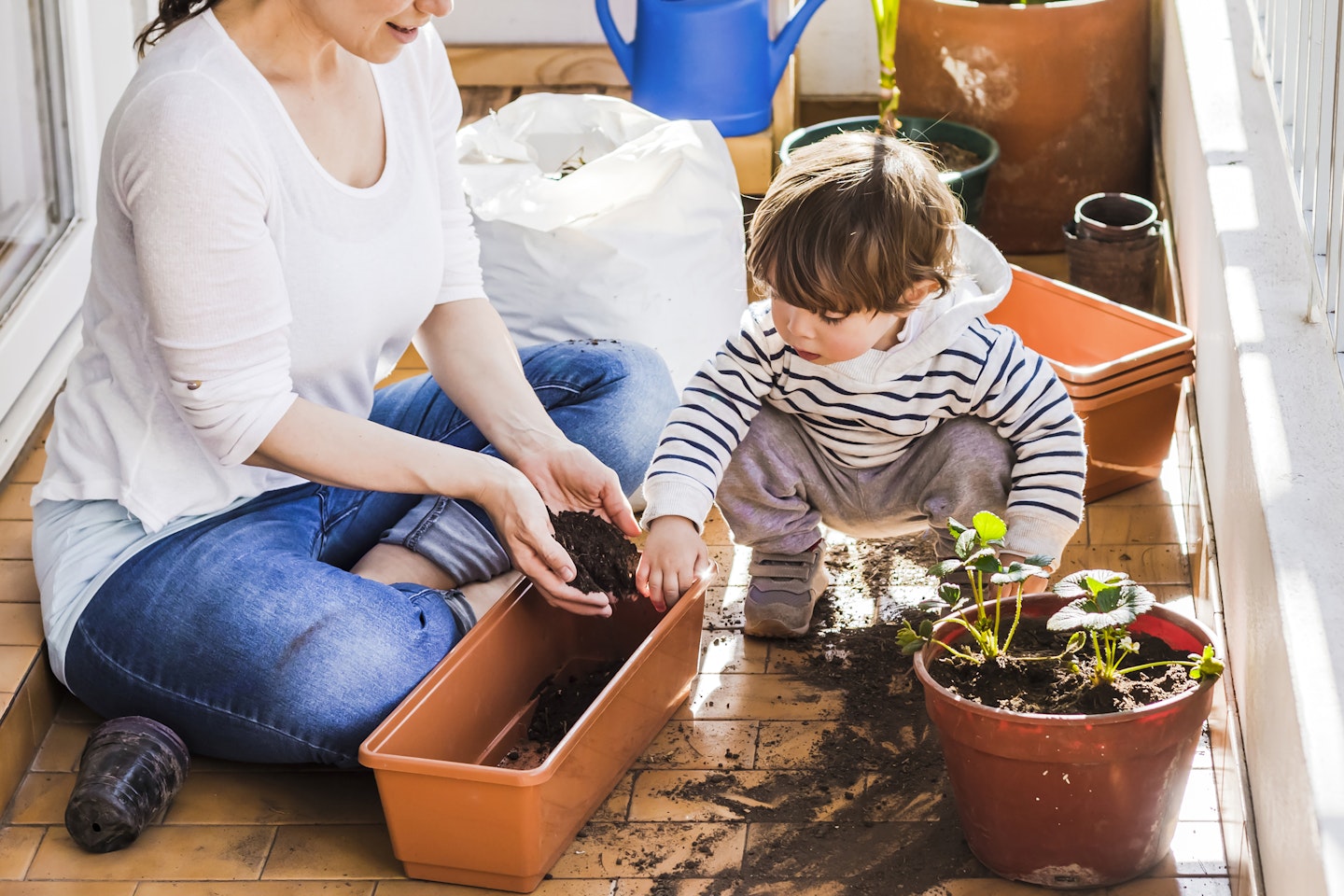As you look at your little bundle of fun, you probably think this Mother’s Day – especially if it’s your first – couldn’t get any better. Yes, she might not be that amazing at getting you presents or making your breakfast in bed just yet, but you can rely on her to gaze at you with all the love and admiration you could probably ever want. So instead of focusing on the material things this year, we want to give you an even better present – the gift of memories of your little one. So we’ve come up with some adorable ways to remember just how gorgeous and perfect she is right now, so you can treasure them forever.
Meet the expert
Dr Linda Papadopoulosis a chartered psychologist and mum.
1. Capture a tiny footprint
In 18 years' time, you'll look from your spiky, lilac-haired teenager to this teeny-tiny footprint, and smile in disbelief at the time gone by. The salt-doughused to create the cast is simple to make, especially if you have an older toddler to help you with the mixing, and you've probably got all the ingredients you need in the cupboard already.
To make the dough, mix together one mug-full of plain flour and one mug-full of table salt in a bowl. Then gradually pour in up to half a mug of tepid water, mixing with your fingers until it forms a dough. It's reached the right consistency when it stops sticking to your fingers. You might not need all the water, but if you think you've used too much, add extra flour to compensate. Knead the dough for a few minutes until it becomes smooth and stretchy. Split the dough into four (there's enough here to make four footprints), and roll one section in the palms of your hands to form a ball. Place on a lightly floured surface and roll gently with a rolling pin to flatten. Then press your baby's foot into the dough.
Lay the cast on a baking tray lined with greaseproof paper and bake in a very cool oven (100°C/gas mark half) for three hours. Remove from the oven, loosen from the greaseproof paper, and check the underside: if it's not fully dried, turn upside down on the tray and return to the oven for a further hour. Leave overnight to cool and harden. If you'd like to paint it, use acrylic paint – gold or silver looks great!
Why you should make this memory
Psychologist and mum Dr Linda Papadopoulos says: 'When your child is older, she'll want to know all about herself. She'll love to hear the story of her birth and what she was like when she was tiny. With something as tangible as this footprint cast, you can say, 'Look at your little foot! Look at how tiny you were then and how big you are now.' It's proof of that timeline, of how she's developed. And it gives you nostalgia too. You will never feel the passage of time more intensely than when you're a parent, and this will be a valuable memento of those earliest years.'

2. Start a Mothers' Day journal
You might think that you'll never forget just how gorgeous your baby is right now, or all those funny words your toddler comes out with, but you can only remember so many, so start a Mothers' Day journal now. As well as it being a record of this and all the Mothers' Days to come, use it to capture a snapshot of your ever-changing family each and every year. Write down those crazy little things that you love about your tot. Ask your partner to note down why he thinks you're a fab mum. Get your tot to add some scribbles too and as he grows, to draw a picture of you, and one day in his finest handwriting explain why he thinks you're the best mum in the world. Stick in the heart torn from a newspaper that arrived with your breakfast in bed, the receipt from the coffee shop where you went for chocolate muffins and Babyccinos, and a photo of you all feeding the ducks afterwards. And instigate a new Mothers' Day tradition to sit down on the sofa as a family, and look through this time capsule of special moments spent together.
Why you should make this memory
Linda says: 'The celebration that is Mothers' Day gives a clear message to our little ones that being a mummy is really important. It's good that we pause and collectively focus on someone that we maybe take for granted. Keeping a journal is a lovely way to express this, although we shouldn't need to wait for a special day to say all these things! It will give your child snapshots of your family through time, and of what's constant within it. Lots of things change as you grow up, but the love and caring of your family don't.'
3. Plant summer-flowering bulbs
However small your garden, if you've got a toddler, put planting allium bulbs on your plan for this Mothers' Day. These bulbs are so straightforward to plant that your toddler can do most of the work, they need no looking after whatsoever, and your tot will love the bright, spherical flowers that will appear in early summer for years and years to come. Your local garden centre will stock allium bulbs, and many supermarkets and DIY stores at this time of year too, with varieties ranging in size from 2cm pom-poms to 20cm globes. The flowers are robust enough to withstand close scrutiny from a curious toddler, will last two weeks if cut and brought inside, and dry to spectacular seedheads on long sticks for autumn swordfights in the garden.
Choose a sunny spot, and dig a hole at least twice the depth of the allium bulb. Push the bulb into the bottom of the hole, with its growing point facing upwards, cover with soil and water well. The bulbs can be grown in pots too, as long as there's at least 4cm of soil between the bottom of the bulb and the base of the pot.

Why you should make this memory
Linda says: 'One of your core tasks as a parent is to create memories with your child. It gives her a sense of history and a sense of connection. Every year these flowers will come up and you'll all be reminded of that time you enjoyed together. And it's great for a little one to learn to wait, that gratification can be delayed. This project is a lovely metaphor, teaching your child that if you nurture something, and take care of it, it'll give you something back.'
4. Video your child saying 'I love you'
We're so busy taking care of all the necessities of looking after a baby that we can sometimes run out of time for the equally important task of emotional housekeeping. Because in a decade or two, you won't be looking back with a tear in your eye remembering how diligently you changed all those nappies. You'll want something that captures what was and still is really important – the unique bond between you and your child.
Which is where this project comes in. Every Mothers' Day, film your tot saying, 'I love you'. Of course, you'll just have to capture a cute gurgle or two for the first couple of years, but gradually your little one will get the hang of your new tradition, and perhaps there'll be more than one voice someday! Put the clips together to make a short film that, even far, far into the future when your child is maybe a parent herself, your family will treasure.
Why you should make this memory
Linda says: 'Most of us don't doubt that our little ones love us, so we don't need proof. But this gives us documentation. Our children give us different things at different stages, and when they are first able to verbalise their love for us is such a seminal moment. It's a moment when you have an amazing connection together, and one you'll want to hold on to. Capture this on film, and you'll play it over and over.'
5. Create a family tree of faces
This activity celebrates not only your relationship with your toddler but all the other important bonds in your family too. It will also gently introduce the concept to her that you are not just her mum, but a daughter too, and perhaps a wife, aunty and cousin too. And show her that Nanny isn’t just her nanny, but your mum as well.
Mothers’ Day is the perfect opportunity to chat about all this. In your tot’s mind right now, the structure of your family is a really abstract and confusing idea – she won’t be able to imagine that you were ever a child, or think of you as anyone other than her mum. This project will allow her to ‘see’ the web of family relationships in a way she can understand.
Before you start, print or find photos of all the family members you wish to include on your family tree. On a large sheet of paper, create a picture of a tree. Tailor how you do this to what activities your tot enjoys – you could use glue and tissue paper, or use paint to make thumb-print or handprint 'leaves'. Stick a photo of your child on the main trunk. Then draw a line upwards and add a photo of you and your partner. Continue with grandparents, aunties, uncles and cousins, until your tree is as big as you wish to make it.
Stick your finished family tree up on the wall at your toddler's eye-level. She will love pointing to the faces and saying the names. And it will help her realise that she is part of a bigger family, and see her place within it.
Why you should make this memory
Linda says: 'This lets your toddler visualise the structure of her family, and see where she belongs. You'll be able to look at the family tree together and say, 'Look, you got your green eyes from Grandpa, and curly hair like Uncle Ted.’ That gives her a sense of connection, of continuity, and that's very grounding. At the moment, she thinks she is the centre-point around which everything revolves, but it's good to be able to expand that view. And one day she'll realise you're not just her mother, but a person too!'
